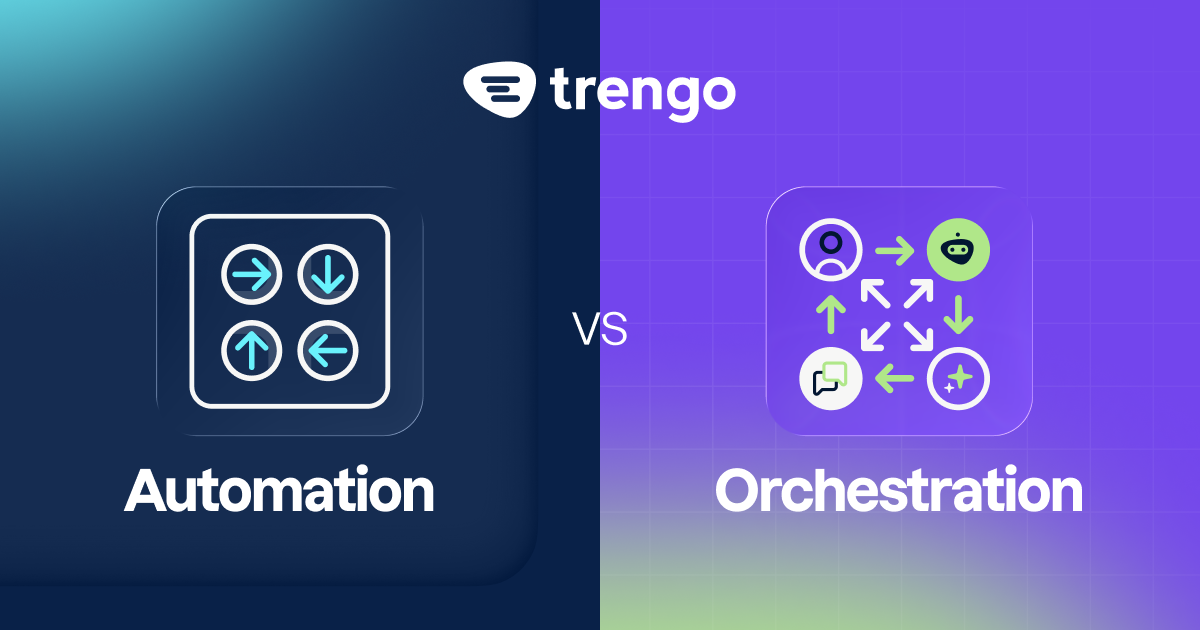As businesses grow and customer expectations rise, finding ways to deliver fast, reliable support is more critical than ever. That’s why many organisations are exploring customer service automation to help their teams manage conversations more efficiently, reduce response times, and keep service quality high.
Of course, automating customer service comes with its own set of challenges. It can sometimes create a sense of distance between brands and customers, and it’s not always the answer for every situation, especially when a human touch is needed.
The key is to strike the right balance between automation and personal connection. In this article, we’ll explain what customer service automation is, how it works, and how you can use it to build a support experience that’s both efficient and genuinely helpful.
What is customer service automation?
Customer service automation is all about using technology to handle customer support tasks that would otherwise require a person. This can include tools like chatbots, artificial intelligence, and self-service portals that answer questions, process requests, or route inquiries—often without needing a human agent to step in.
Instead of relying solely on traditional, agent-led support, customer service automation allows businesses to provide help around the clock and manage a higher volume of requests as they grow. Automated systems can instantly respond to common questions, guide customers to relevant information, and even sort incoming issues so that the right team handles them.
Automating repetitive or straightforward tasks allows customer service teams to focus on more complex problems and build stronger relationships with customers. In short, customer service automation helps create a more efficient, scalable, and consistent support experience for everyone involved.
The key benefits of customer service automation
Customer service automation benefits businesses in several important ways, helping teams deliver better support while saving time and resources.
Improved efficiency and productivity
Customer service automation streamlines repetitive tasks like answering common questions or routing tickets, allowing support agents to focus on more complex or sensitive issues. This not only helps teams manage higher volumes of requests but also reduces the risk of tickets slipping through the cracks.
24/7 support for customers
Automated systems, such as chatbots and virtual assistants, are always available. This means customers can get instant answers to their questions at any time, even outside of standard business hours. As a result, customer satisfaction increases because help is always just a click away.
Faster response and resolution times
By handling straightforward requests instantly, customer service automation speeds up response and resolution times. This leads to shorter wait times for customers and boosts key support metrics like first contact resolution and average handle time.
Lower operational costs
Automating routine support tasks reduces the need for large customer service teams, helping businesses save on hiring, training, and staffing costs. Many companies see significant cost reductions after implementing automation, all while maintaining high-quality service.
Consistent and accurate support
Automated systems follow set guidelines and provide reliable, on-brand responses every time. This ensures customers receive consistent information, which builds trust and helps maintain a uniform tone and voice across all channels.
Scalability as your business grows
As demand increases, customer service automation can handle more interactions without additional staffing. This makes it easier for businesses to scale their support operations and maintain service quality during busy periods.
Enhanced customer experience
With automation handling routine tasks, support agents can spend more time delivering personalised, empathetic service when it matters most. At the same time, customers can access self-service options and get issues resolved on their own terms, leading to greater independence and satisfaction.
In short, customer service automation benefits both businesses and their customers by making support faster, more reliable, and more cost-effective.
How does customer service automation work?
How customer service automation works is by using smart technology to handle support tasks more efficiently. Tools like chatbots, AI assistants, and self-service portals can answer common questions, guide customers, and resolve routine requests, often without a human agent.
Here’s how it typically functions:
- Chatbots and virtual assistants provide instant, 24/7 answers to frequently asked questions and basic issues.
- Automated ticket routing sorts and directs more complex inquiries to the right team or agent, so nothing gets missed.
- Self-service knowledge bases let customers quickly find solutions on their own, reducing the number of incoming tickets.
- Automation sends proactive updates, like order confirmations or shipping notifications, so customers stay informed.
- These systems often integrate with other business tools, giving agents the information they need when a personal touch is required.
By automating repetitive tasks, customer service automation speeds up support, improves consistency, and lets agents focus on more complex customer needs.
Real-world customer service automation examples
Customer service automation examples are everywhere, from simple tools to advanced AI-powered solutions. Here are some of the most common ways businesses are automating support today:
- AI agents
Modern AI agents can handle entire conversations, answer questions, resolve issues, and even escalate complex cases to human agents when needed. They work around the clock, offering instant help and freeing up your team for more challenging tasks. - Automated ticketing systems
Automation can sort, prioritise, and route customer inquiries to the right agent or department. This speeds up response times and ensures that no ticket slips through the cracks. - Interactive voice response (IVR) systems
IVR lets customers interact with an automated phone system to get information, make payments, or be routed to the right person. It’s a staple for banks, utilities, and contact centres looking to provide quick answers and reduce wait times. - Intelligent routing
With intelligent routing, customer requests are automatically directed to the most suitable agent or resource based on their needs, agent skills, or availability. This improves efficiency and customer satisfaction. - Autoresponders and canned messages
Automated email and chat replies give customers instant confirmation or answers to common questions, keeping them informed while reducing manual work for your team. - Automated notifications
Automation can send proactive updates, such as order confirmations, shipping alerts, or appointment reminders, so customers always know what’s happening with their requests. - AI-powered knowledge bases
These self-service resources help customers find answers on their own, using AI to suggest relevant articles or solutions based on the customer’s question. - Workflow automation
Automated workflows keep support processes moving, from escalating urgent tickets to following up on unresolved issues, making sure nothing gets missed. - Predictive analytics
Automation tools can analyse customer data to predict needs, spot trends, and help you offer more proactive support. - Automatic translation
Language translation tools allow you to serve customers globally without language barriers, expanding your reach and improving the customer experience.
These customer service automation examples show how technology can streamline support, improve response times, and help teams deliver a better experience for every customer.
How to get started with automation in customer service
Ready to bring automation in customer service to your business? Here’s a practical step-by-step guide to help you get started:
1. Identify automation opportunities
Begin by reviewing your current customer service interactions. Look for repetitive tasks and common questions, like answering FAQs, routing inquiries, or sending order updates, that take up a lot of your team’s time. These are perfect candidates for automation.
2. Choose the right tools
Select automation tools that fit your business needs and can integrate with your existing systems. Look for features like chatbots, automated ticketing, and knowledge bases that are user-friendly and scalable as your business grows.
3. Build self-service options
Create a comprehensive knowledge base with FAQs, guides, and troubleshooting articles. This empowers customers to find answers themselves and reduces the pressure on your support team.
4. Implement chatbots and virtual assistants
Deploy chatbots that can handle routine questions and guide customers through basic troubleshooting. Make sure they’re well-trained and can escalate complex issues to human agents when needed.
5. Set up automated ticketing
Use automated ticketing systems to capture and route inquiries from all channels. Set rules for prioritising and assigning tickets to the right agents, and keep customers informed with automatic updates.
6. Automate communication
Set up automated emails and notifications for order confirmations, reminders, and updates. Use templates for common issues to provide quick, consistent responses.
7. Integrate your systems
Ensure your automation tools connect seamlessly with your CRM and help desk platforms. This creates a unified view of each customer and streamlines workflows for your team.
8. Train your team
Support your staff with training on the new tools. Teach them when to step in and how to complement automated interactions with a personal touch.
By following these steps, you can successfully implement automation in customer service, making your support more efficient, consistent, and scalable as your business grows.
Potential disadvantages of customer service automation
While automation of customer service can make things faster and more efficient, it does have some drawbacks to consider.
The biggest concern is losing the personal touch that many customers value. Automated systems can feel impersonal, especially when someone is upset or dealing with a complicated issue. If customers can’t easily reach a real person when they need to, it can lead to frustration and even lost business.
Customer service automation should never fully replace human support. It’s important to give customers the option to speak with a person, especially for sensitive or complex situations. The key is to use automation to handle simple tasks and free up your team while still making sure customers feel heard and supported when it matters most.
Best practices for customer service automation
To get the most from customer service automation and avoid common pitfalls, it’s important to follow a few best practices:
Automate the right tasks
Focus on repetitive, simple tasks like answering FAQs, sending order updates, or routing tickets, so your team can spend more time on complex issues that need a human touch.
Keep self-service easy
Build a clear, helpful knowledge base and make sure customers can easily find answers themselves. This empowers customers and reduces the volume of incoming requests.
Maintain a human touch
Always offer customers a way to reach a real person, especially for sensitive or complicated issues. Automation should support your team, not replace it.
Use automation across all channels
With tools like Trengo, you can automate responses on chat, email, WhatsApp, and social media, ensuring customers get consistent support wherever they reach out.
Monitor and improve
Regularly review feedback and performance data to spot issues and improve your automated systems. Test and refine your automation to keep it effective and customer-friendly.
Integrate your systems
Make sure your automation tools work seamlessly with your CRM and other platforms, so your team always has the full picture and can deliver a smooth customer experience.
By following these best practices, you can use customer service automation to boost efficiency, keep customers happy, and avoid the common challenges that come with automated support.
How to check if your customer service automation is working?
Making sure your customer service automation is effective doesn’t have to be complicated. Start by testing the customer journey yourself—see where things feel smooth and where they don’t.
Here are some simple ways to check if your customer service automation is on track:
- Review customer feedback and survey responses to spot patterns and areas for improvement.
- Track key metrics like response time, resolution rates, and customer satisfaction scores to measure performance.
- Monitor where customers drop off or abandon automated flows, and refine those areas for a better experience.
- Regularly review conversations between customers and bots to identify gaps or issues.
By keeping an eye on these points, you can fine-tune your customer service automation and make sure it’s delivering the results you want.
Combining automation with a personal touch
Customer service automation works best when it complements, not replaces, human interaction. While automation can handle routine questions and speed up support, it’s the personal touch from your team that builds real relationships and trust with customers.
The most successful businesses use customer service automation to take care of repetitive tasks, freeing up agents to focus on complex or sensitive issues that need empathy and expertise. Clear paths for escalation to a human agent are essential, ensuring customers always feel heard and valued.
With Trengo, you can automate conversations across all your channels while keeping the option for personal support just a click away. Ready to see how the right balance of automation and human touch can transform your customer experience?




.png)











